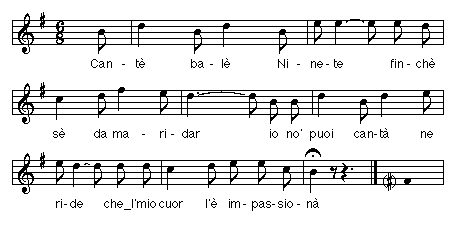Ex. 6, "La prova" (Nigra 54)
Morelli and Starec report that in Trentino and Friuli, two regions of Northern Italy, all ballads are sung either in thirds or in solo style, retaining the voice that the performer is used to singing. In his commentary on Wassermann's collection, Starec says, "The melodies ending on the third degree, that are conceived as upper lines of a polyphonic performance, are twice the number of the melodies ending on the tonic. It is well known that the singers, even in solo performances, choose the upper or the lower part on the basis of which part they like best and of the role they are used to performing in polyphonic performances" (Wassermann 1991:313). In an example from Wasserman's collection, (ibid.:320), an old woman sings the melody taking the upper part of a song transcribed in G Major (originally in D Major). If originally a two-voice song, it presumably belongs to Type 1, but in this case has no solo section. It begins and ends on the third degree, has a limited range, and, characteristic of upper voices, the seventh degree descends instead of ascending to the tonic.

Transcription from Wasserman 1991:320
Return to Magrini music analysis main page
